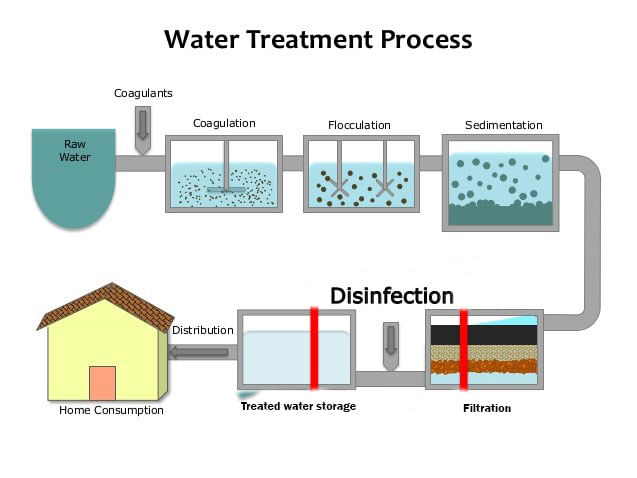Class 10 Exam > Class 10 Notes > Chemistry for GCSE/IGCSE > Treatment of Domestic Water
Treatment of Domestic Water | Chemistry for GCSE/IGCSE - Class 10 PDF Download
Water supply
- Water is sourced from rivers, reservoirs, or subterranean water bodies like groundwater.
- An aquifer refers to a geological formation capable of storing water.
Water Treatment
- Raw water contains both soluble and insoluble impurities.
- Insoluble impurities consist of soil, plant fragments, and organic matter.
- Soluble impurities include dissolved calcium, metallic compounds, and various inorganic pollutants.
- Water is directed into sedimentation tanks where it remains stationary for several hours.
- Sedimentation occurs as gravity causes mud, sand, and other particles to settle at the tank's bottom, forming a sediment layer.
- Filtration involves passing water through layers of sand and gravel filters to capture smaller particles.
- Additionally, water can be filtered through activated carbon, typically in charcoal form, to eliminate tastes and odors.
- Chlorination is employed to eradicate bacteria and microorganisms that cannot be trapped by filters.
- Chlorine is carefully added to the water to kill harmful bacteria and microorganisms.
- Untreated water consumption can lead to bacterial infections such as cholera and typhoid.
- Diagram showing the stages in the treatment of water:

Question for Treatment of Domestic WaterTry yourself: What is the purpose of chlorination in the water treatment process?View Solution
The document Treatment of Domestic Water | Chemistry for GCSE/IGCSE - Class 10 is a part of the Class 10 Course Chemistry for GCSE/IGCSE.
All you need of Class 10 at this link: Class 10
|
72 videos|162 docs|61 tests
|
FAQs on Treatment of Domestic Water - Chemistry for GCSE/IGCSE - Class 10
| 1. How does water treatment help improve the quality of domestic water? |  |
Ans. Water treatment helps remove impurities, contaminants, and bacteria from domestic water, making it safe for consumption and use in households.
| 2. What are the common methods used in water treatment for domestic water? |  |
Ans. Common methods used in water treatment for domestic water include filtration, disinfection (such as chlorination), sedimentation, and coagulation.
| 3. How often should domestic water undergo treatment? |  |
Ans. Domestic water should undergo treatment regularly, depending on factors such as the source of water, the presence of contaminants, and the level of usage.
| 4. What are the potential health risks associated with consuming untreated domestic water? |  |
Ans. Consuming untreated domestic water can lead to waterborne diseases such as cholera, typhoid, and dysentery due to the presence of harmful bacteria and contaminants.
| 5. Can individuals install water treatment systems in their homes for domestic water? |  |
Ans. Yes, individuals can install water treatment systems such as water filters, UV purifiers, and reverse osmosis systems in their homes to ensure the quality and safety of their domestic water supply.
Related Searches















